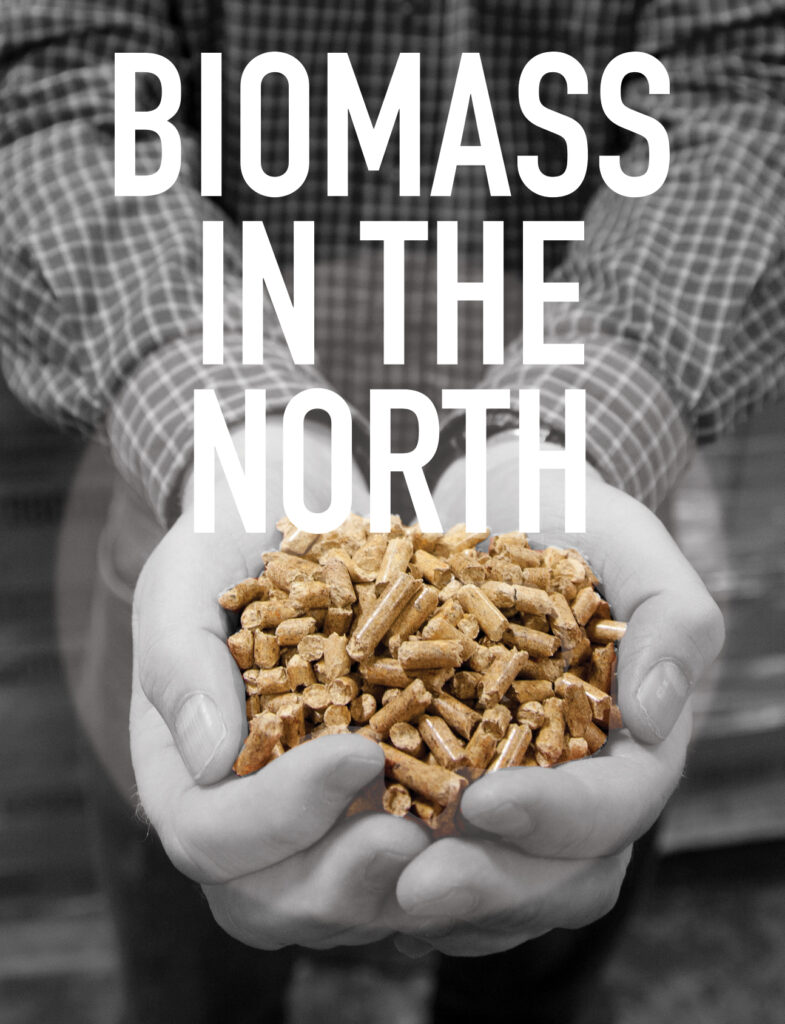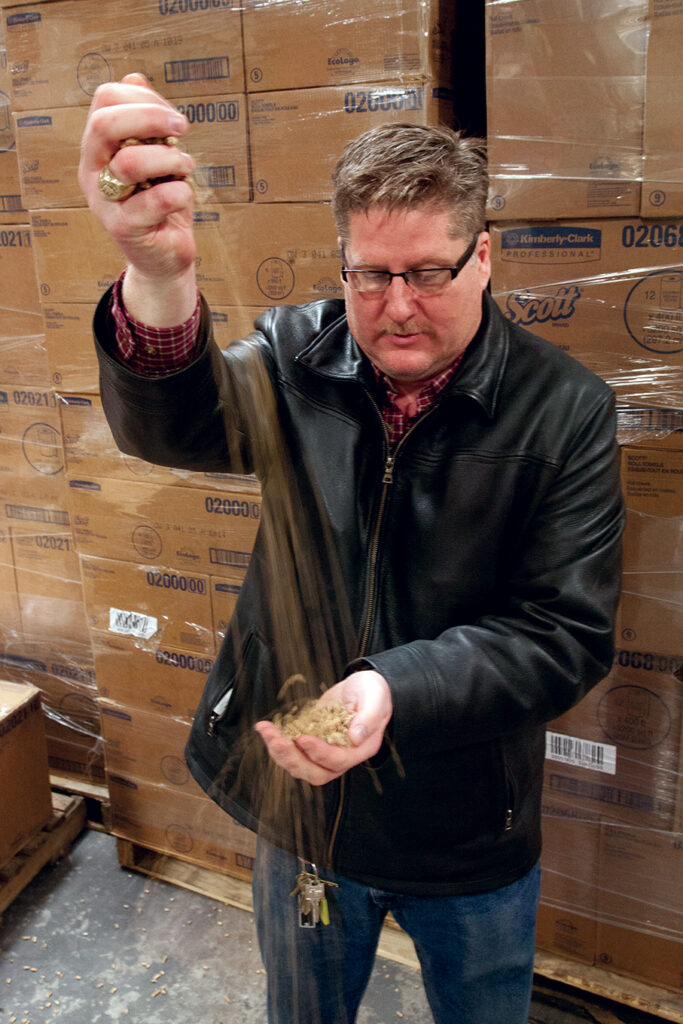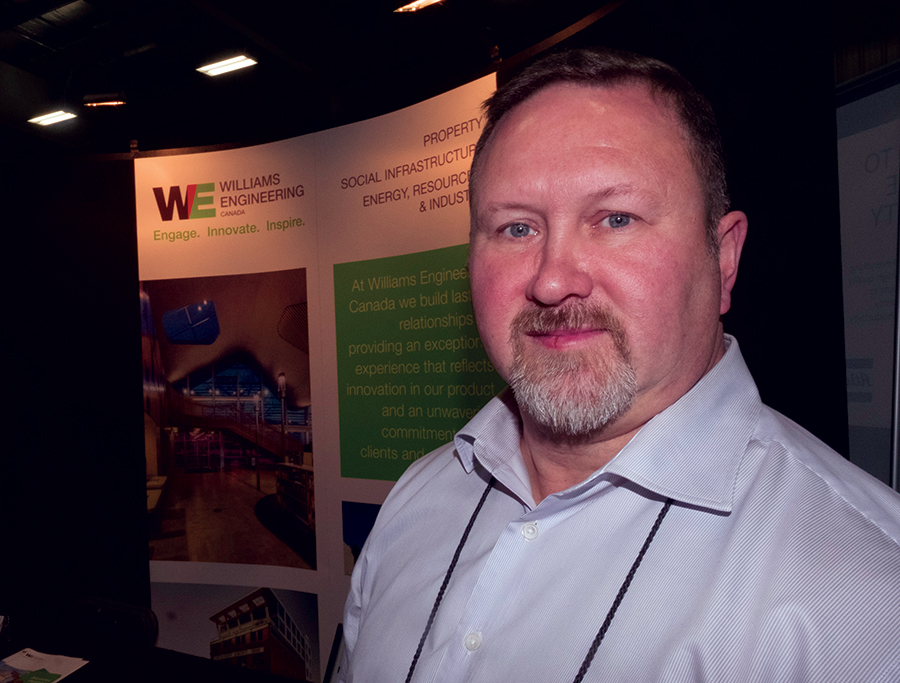Generating lots of heat, and now, also plenty of light

By Graham Chandler
In 2003, Bruce Elliott paid $46,000 in heating bills for his 10,000 sq. ft. factory in Yellowknife. Three years later, he paid $18,000. An accounting miracle? A precipitous drop in the price of oil? Neither of the above. Elliott, the owner of Fiberglass North, switched from oil to biomass heating, the first Northwest Territories business to do so. He was so impressed with it over the years he founded a brand new business called Arctic Green Energy Corporation. Biomass energy is now gathering momentum in the NWT as several companies and homeowners are taking advantage of the much lower monthly heating costs from using biomass heating systems.
Fiberglass North’s heating bill was large because the air in the factory has to be changed every 15 minutes to drive fumes out of the plant. “You can’t recycle the hot air because of the dust and the fiberglass,” explains Elliott. “We just exhaust it. So our heating bill was equivalent to a 60,000 square foot factory.” Looking for alternatives, he considered coal, which then was only about 30 dollars a tonne. In searching for a coal-fired boiler he phoned a Winnipeg manufacturer. “They said why do you want to burn coal? I said I’ll burn anything that will cut my cost,” he says. “They said we can cut your costs in half and I said great. Found out the feds had a grant for nearly 50 percent of the cost of installing a pellet boiler. So that’s how it happened.” Ever the entrepreneur, Elliott spied a new business opportunity – the pellet business, especially for large commercial applications. He went looking for clients and the first one was the Government of the Northwest Territories, who, he says, were having problems heating the new jail. “Because of my tank business, I knew everyone in the Department of Public Works and Services (PWS), so had a meeting and offered to install 1.5 megawatts of pellet boilers.”

PWS was understandably skeptical, Elliot recalls. “They said no one can heat a building with those little bits of wood. So I said I will do it and sell you the heat, under the price of oil,” Elliot says. “It was one of the first large pellet boilers in Canada. When we started no one knew what we were talking about.” It certainly caught the attention of Andrew and Marilyn Taylor of Hay River. “Bruce Elliott is probably one of the pioneers of biomass here,” says Andrew. “If it wasn’t for him I don’t know if biomass would have got to where it is today. He was kind of my mentor and one of the first to put the big commercial-style systems on stream. Everybody looked at it and said ‘hey, this is good, this works’.” They started Taylor & Co. in 1997 as a mechanical contracting company, but when they incorporated in 2002, they decided to diversify and include the nascent biomass market. “No one was really taking it seriously and so I got into the biomass and alternative energies,” says Andrew. He thought it was a bit of a risk, as any new venture is, but it fit well with Taylor’s mechanical contracting business. Andrew reckoned the biomass and alternative energy market was going to grow, “and it just kept growing and growing,” he says.
Taylor’s renewables business is not all biomass; they also sell solar power systems, among other renewables. “Solar has come a long way,” he says. “We are always looking at solar projects along with our biomass because there’s a market for it here. Multiple projects have biomass and solar. I’m not sure why wind hasn’t taken off but I think farther north in the Inuvik area they get a better breeze. We are in the tree line so probably don’t get the wind as much.” Andrew says there is a big shift to alternative energy occurring in the mechanical industry and in the entire HVAC industry, which works wells for his company. “It gives us another avenue for opening up our share of the mechanical business market,” he says, in addition to the environmental benefits that are a big driver. “I think all of North America needs to be paying attention to that part of it,” he says. Renewables now form 20 to 25 percent of the company’s business activity, making it one of the larger suppliers of pellets in the NWT.

The GNWT has been a big proponent of biomass. The government’s Northwest Territories Biomass Energy Strategy of 2012-2015 supports the facilitation of conditions for biomass to become an integral part of a more sustainable energy mix by establishing effective government policies and programs. The strategy supports private sector innovation and initiative in developing biomass energy markets and building strong partnerships with communities, First Nations, other levels of government and the private sector. Aiding many companies’ efforts to expand the use of biomass heating is Williams Engineering. “We do a lot of design work,” says Steven Meister, Williams’ Regional Director for the Arctic. “We are probably the premier engineering firm for designing biomass systems with wood power,” Meister says that Williams does a lot of mechanical systems engineering across the north, making biomass a natural synergy for the company. Williams works closely with individuals and companies in the North that are involved with selling and installing mechanical systems and biomass systems. While Williams doesn’t manufacture furnaces, the company puts the heating systems together. Meister says its important for Williams to keep up with the technology in order to engineer it properly and ensure it provides maximum benefit to users.
At present, all pellets used in biomass systems for the north are shipped in, usually from Alberta. The rising popularity of this energy source has prompted at least one northern entrepreneur to diversify into the construction of a pellet manufacturing plant utilizing local wood. Brad Mapes had been operating Wesclean Northern Sales, founded by his father in 1975, providing janitorial and industrial supplies, transportation, flooring, paint and wallcoverings in Hay River, when he got the biomass manufacturing bug five years ago. A long time Northerner, Mapes says he has always tried to think outside the box to create new job opportunities in the North. “I just got thinking one day and looked at all the trees. Then there was a load of pellets that got dumped in a ditch outside of town and I saw how quickly they could clean it up without any environmental issues and from there I kind of got the ball rolling with some ideas, he says.” He launched Aurora Wood Pellets Ltd. with a plan to purchase land at Enterprise, build a pellet plant and utilize local workers to harvest wood as the feedstock. The project is advancing, with the recent purchase of 320 hectares. “The hamlet has given us the OK. We are just in the legal process,” says Mapes. “We’ll probably see the title by January.”

They then plan to start clearing and surveying the land in May, with the construction of the mill slated for summer 2016. Mapes expects mill construction to take about 12-14 months, and cost up to $20 million. “But that could change a bit depending on the harvest amount,” he says. “Basically, we are just waiting for a few of our other harvesting areas to come onside with the amount. One of the issues we have is determining how big of a dryer system that we are going to put into our project.” Mapes explains that the dryer system size is key and needs to be in line with tree harvest amounts. “If you make it too small, you’re going to have issues in the long run,” he says. “So we need to make sure that we firm up on what we are actually going to be able to harvest.” For wood supply, he has two of the larger Forest Management Agreements in hand: Fort Resolution and Fort Providence, and hopes to have a few more. This will provide feedstock for the anticipated initial output of 150,000 to 200,000 tonnes a year. “We’ll be the first actual producer in the north,” he says. Mapes isn’t too worried about competition from the south because his plans call for the production of a premium pellet made only of white wood without any bark that will be sold for more than other pellets currently on the market. “We won’t be using any byproduct,” he says. “It’s a higher heat content.”
Aurora’s planned output in fact far exceeds the current market size of Canada’s north, so part of the plan is to export to both domestic and international markets, where Mapes says they again should have an edge. “Our 25-year (supply) agreements give us security of timber whereas a lot of the mills in the south have issues with the fact that they are relying on one- or two-year guaranteed supply contracts.” The attraction of local employment for harvesting drives another biomass option – using wood chips instead of pellets. Elliott doesn’t think the north should stay with pellets and should move more to wood biomass. “I am a believer in biomass rather than straight pellets,” he says. “The trouble with pellets is the high cost to briquette them and pelletize them.” He advocates utilizing wood from the two and a half million hectares burnt by the recent massive forest fires. “They are only 4 to 6 inches in diameter but there are millions of them.” He reckons they could be harvested for $50 per tonne, which is less than one-third the price of pellets.
Williams Engineering’s Meister says there are no real engineering challenges to using either format, just a different design. “Both have their pros and cons,” he says. “If you are in a local market and just trying to harvest a local resource, obviously it is a simpler process if you just have the chip at a certain size, dry it, feed it into a hopper and burn it.” On the other hand, he says manufactured pellets for residential areas with limited space can be easily handled and moved. The market is not all biomass. Although Canadian Quest Logistics (CQL) partnered with Arctic Green Energy in 2013 to provide district heating solutions throughout the Northwest Territories using biomass, more recently they’ve been concentrating efforts toward other forms of renewable energy for the North. According to Roger Anderson, CQL’s chief executive officer, Northwest Territories Housing Corporation (NTHC) has signed a design-build contract with CQL to construct a senior living multiplex in Fort McPherson. A stipulation of the contract was that the building should support a 20 kW solar-ready, grid-tied photovoltaic solar system.” That project should be completed by March 31, 2016.
Anderson says NTHC has signed a design build contract with TJ’s Contracting to erect a similar seniors living multiplex in Fort Good Hope with the same stipulation in the contract. “CQL will supply engineering (mechanical, structural, and electrical), as well as project management services for the project,” says Anderson. “We were responsible for tendering, and successfully negotiating, the winning project.” The project is expected to wrap up by August 30, 2016. Anderson says the estimated cost of the photovoltaic systems for both projects is $300,000. For CQL, promoting renewable energy is more than winning contracts. The company is leading the charge with its new headquarters. “We expect to construct our new head office in Inuvik in 2016, which will incorporate both solar and biomass energy sources, and a small wind unit,” says Anderson. “The office will serve as a demonstration unit, for the latest technologies in alternative energy sources, as well as energy conservation technologies. It is our expectation that more businesses will use the technologies after reviewing the performance in CQL’s ‘test facility’ type head office.” CN

